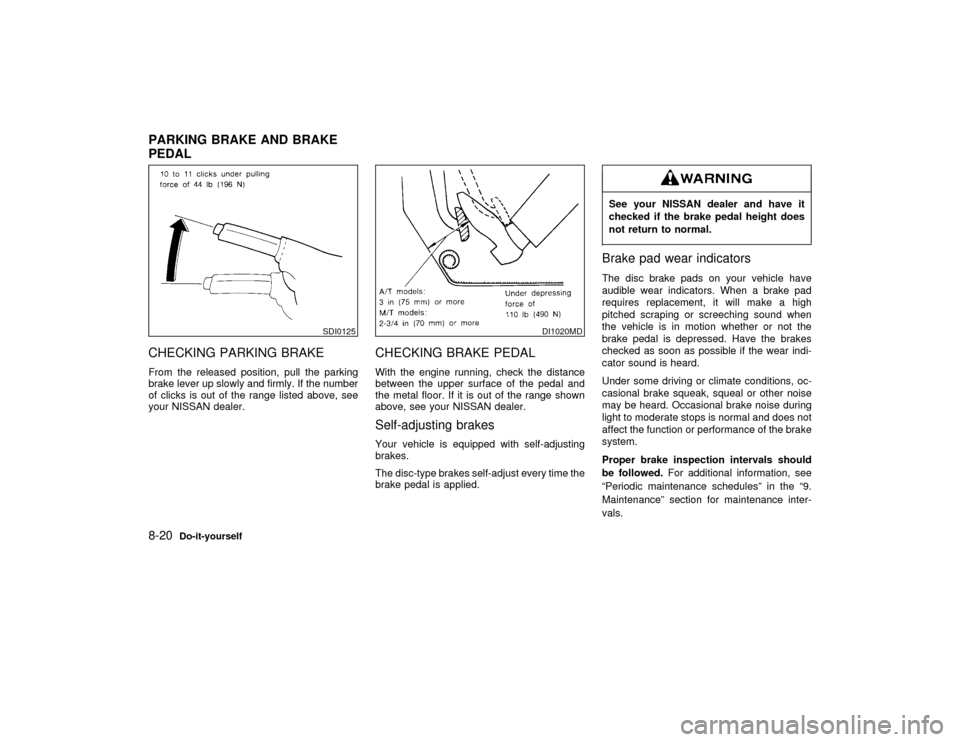1998 NISSAN MAXIMA brake pads
[x] Cancel search: brake padsPage 56 of 231

BUZZERS
Key reminder buzzerThe buzzer will sound if the driver side door is
opened while the key is left in the ignition
switch (ignition switch is turned off). Remove
the key and take it with you when leaving the
vehicle.Light reminder buzzerA buzzer will sound when the driver side door
is opened if the light switch is turned on
(ignition switch is turned off).
Turn the light switch off when you leave the
vehicle.Brake pad wear warningThe disc brake pads have audible wear warn-
ings. When a brake pad requires replacement,
it will make a high pitched scraping sound
when the vehicle is in motion whether or not
the brake pedal is depressed. Have the brakes
checked as soon as possible if the warning
sound is heard.
THEFT WARNINGThe theft warning system provides visual and
audio alarm signals if parts of the vehicle are
disturbed.
IC0005
SECURITY SYSTEM (if so
equipped)
Instruments and controls
2-11
Z
01.1.31/A32-D
X
Page 132 of 231

4. Turn the ignition key to the LOCK position
and remove the key.INever leave the engine running while
the vehicle is unattended.
INever leave children unattended in
the vehicle.
The power assisted steering is designed to
use a hydraulic pump, driven by the engine, to
assist steering.
If the engine stops or drive belt breaks, you will
still have control of the vehicle. However,
much greater steering effort is needed, espe-
cially in sharp turns or at low speeds.If the engine is not running or is turned
off while driving, the power assist for the
steering will not work. Steering will be
much harder to operate.
The brake system has two separate hydraulic
circuits. If one circuit develops a problem, you
will still have braking at two wheels.
Vacuum assisted brake
The brake booster aids braking by using en-
gine vacuum. If the engine stops, you can stop
the vehicle by depressing the brake pedal.
However, greater foot pressure on the brake
pedal will be required to stop the vehicle and
the stopping distance will be longer.
Wet brakes
When the vehicle is washed or driven through
water, the brakes may get wet. As a result,
your braking distance will be longer and the
vehicle may pull to one side during braking.
To dry brakes, drive the vehicle at a safe
speed while lightly pressing the brake pedal to
heat-up the brakes. Do this until the brakes
return to normal. Avoid driving the vehicle at
high speeds until the brakes function correctly.
Using the brakes
Avoid resting your foot on the brake pedal
while driving. This overheats the brakes, in-
creases wear on the brake linings and pads,
and reduces gas mileage.
To help save the brakes and to prevent the
brakes from overheating, reduce speed and
POWER STEERING BRAKE SYSTEM
Starting and driving
5-17
Z
01.1.31/A32-D
X
Page 175 of 231

CHECKING PARKING BRAKEFrom the released position, pull the parking
brake lever up slowly and firmly. If the number
of clicks is out of the range listed above, see
your NISSAN dealer.
CHECKING BRAKE PEDALWith the engine running, check the distance
between the upper surface of the pedal and
the metal floor. If it is out of the range shown
above, see your NISSAN dealer.Self-adjusting brakesYour vehicle is equipped with self-adjusting
brakes.
The disc-type brakes self-adjust every time the
brake pedal is applied.
See your NISSAN dealer and have it
checked if the brake pedal height does
not return to normal.Brake pad wear indicatorsThe disc brake pads on your vehicle have
audible wear indicators. When a brake pad
requires replacement, it will make a high
pitched scraping or screeching sound when
the vehicle is in motion whether or not the
brake pedal is depressed. Have the brakes
checked as soon as possible if the wear indi-
cator sound is heard.
Under some driving or climate conditions, oc-
casional brake squeak, squeal or other noise
may be heard. Occasional brake noise during
light to moderate stops is normal and does not
affect the function or performance of the brake
system.
Proper brake inspection intervals should
be followed.For additional information, see
ªPeriodic maintenance schedulesº in the ª9.
Maintenanceº section for maintenance inter-
vals.
SDI0125
DI1020MD
PARKING BRAKE AND BRAKE
PEDAL8-20
Do-it-yourself
Z
01.1.31/A32-D
X
Page 198 of 231

Abbreviations: I = Inspect. Correct or replace if necessary.MAINTENANCE OPERATIONMAINTENANCE INTERVAL
Perform at number of miles, kilometers or
months, whichever comes first.Miles x 1,000 3.75 7.5 11.25 15 18.75 22.5 26.25 30 33.75 37.5 41.25 45 48.75 52.5 56.25 60
(km x 1,000) (6) (12) (18) (24) (30) (36) (42) (48) (54) (60) (66) (72) (78) (84) (90) (96)
Months 3 6 9 12 15 18 21 24 27 30 33 36 39 42 45 48Chassis and body maintenanceBrake lines & cablesIIII
Brake pads & discsIIIIIIII
Manual & automatic transaxle oil See NOTE (1).IIII
Steering gear & linkage, axle & suspension partsIIIIIIII
Exhaust systemIIIIIIII
Front drive shaft bootsIIIIIIII
Supplemental air bag system See NOTE (2).NOTE: (1) If towing a trailer, using a camper or a car-top carrier, or driving on rough or muddy roads, change (not just inspect) oil at
every 30,000 miles (48,000 km) or 24 months.
(2) Inspect the supplemental air bag system 10 years after the date of manufacture noted on the F.M.V.S.S. certification label.
Maintenance
9-7
Z
01.1.31/A32-D
X
Page 200 of 231

Abbreviations: I = Inspect. Correct or replace if necessary.MAINTENANCE OPERATIONMAINTENANCE INTERVAL
Perform at number of miles, kilometers or
months, whichever comes first.Miles x 1,000 7.5 15 22.5 30 37.5 45 52.5 60
(km x 1,000) (12) (24) (36) (48) (60) (72) (84) (96)
Months 6 12 18 24 30 36 42 48Chassis and body maintenanceBrake lines & cablesIIII
Brake pads & discsIIII
Manual & automatic transaxle oilIIII
Steering gear linkage, axle & suspension parts I I
Exhaust systemII
Front drive shaft bootsIIII
Supplemental air bag system See NOTE (1).NOTE: (1) Inspect the supplemental air bag system 10 years after the date of manufacture noted on the F.M.V.S.S. certification label.
Maintenance
9-9
Z
01.1.31/A32-D
X
Page 201 of 231

EXPLANATION OF MAINTENANCE
ITEMSAdditional information on the following
items with ª*º is found in the ª8. Do-it-
yourselfº section.Emission control system
maintenanceDrive belts*:Check drive belts for wear, fray-
ing or cracking and also for proper tension.
Replace the drive belts if found damaged.
Air cleaner filter:Under normal driving con-
ditions, the air cleaner filter should be replaced
in accordance with the maintenance schedule.
However, driving the vehicle in dusty areas
may cause more rapid clogging of the element.
Consequently, the element may have to be
replaced more frequently.
EVAP vapor lines:Check EVAP vapor lines
and connections for failure or looseness. If
leaks are found, replace them.
Fuel lines:Check the fuel hoses, piping and
connections for leaks, looseness or deteriora-
tion. Replace any parts if they are damaged.Fuel filter:If the vehicle is operated under
extremely adverse weather conditions or in
areas where ambient temperatures are either
extremely low or extremely high, the filter
might become clogged. In such an event,
replace the filter immediately.
Engine coolant*:Drain and flush the cooling
system.
Engine oil & oil filter*:Under normal driving
conditions, the engine oil and oil filter should
be replaced in accordance with the mainte-
nance schedule. However, under severe driv-
ing conditions, they may have to be replaced
more frequently.
Spark plugs*:Replace with new plugs having
the correct heat range.
Intake & exhaust valve clearance:Check the
valve clearance if valve noise increases.
Chassis and body maintenanceBrake lines & cables:Check the brake lines
and hoses (including brake booster vacuum
hoses, connections & check valve) and park-
ing brake cables for proper attachment, leaks,
cracks, chafing, abrasion, deterioration, etc.Brake pads & discs:Check these and the
other neighboring brake components for wear,
deterioration and leaks. Under severe driving
conditions, they may have to be inspected
more frequently.
Manual & automatic transaxle fluid*:Check
the fluid level and visually inspect for signs of
leakage.
Under severe driving conditions, the oil should
be replaced at the specified interval.
Steering gear & linkage, axle & suspension
parts, and drive shaft boots:Check for dam-
age, looseness and leakage of oil or grease.
Under severe driving conditions, more fre-
quent inspection should be performed.
Exhaust system:Visually check the exhaust
pipes, muffler, and hangers for proper attach-
ment, leaks, cracks, chafing, abrasion, dete-
rioration, etc. Under severe driving conditions,
inspection should be performed more fre-
quently.
Supplemental air bag, and supplemental
side air bag (if so equipped) systems:Main-
tenance for the supplemental air bags or
supplemental side air bags should be done by
an authorized NISSAN dealer.
9-10
Maintenance
Z
01.1.31/A32-D
X